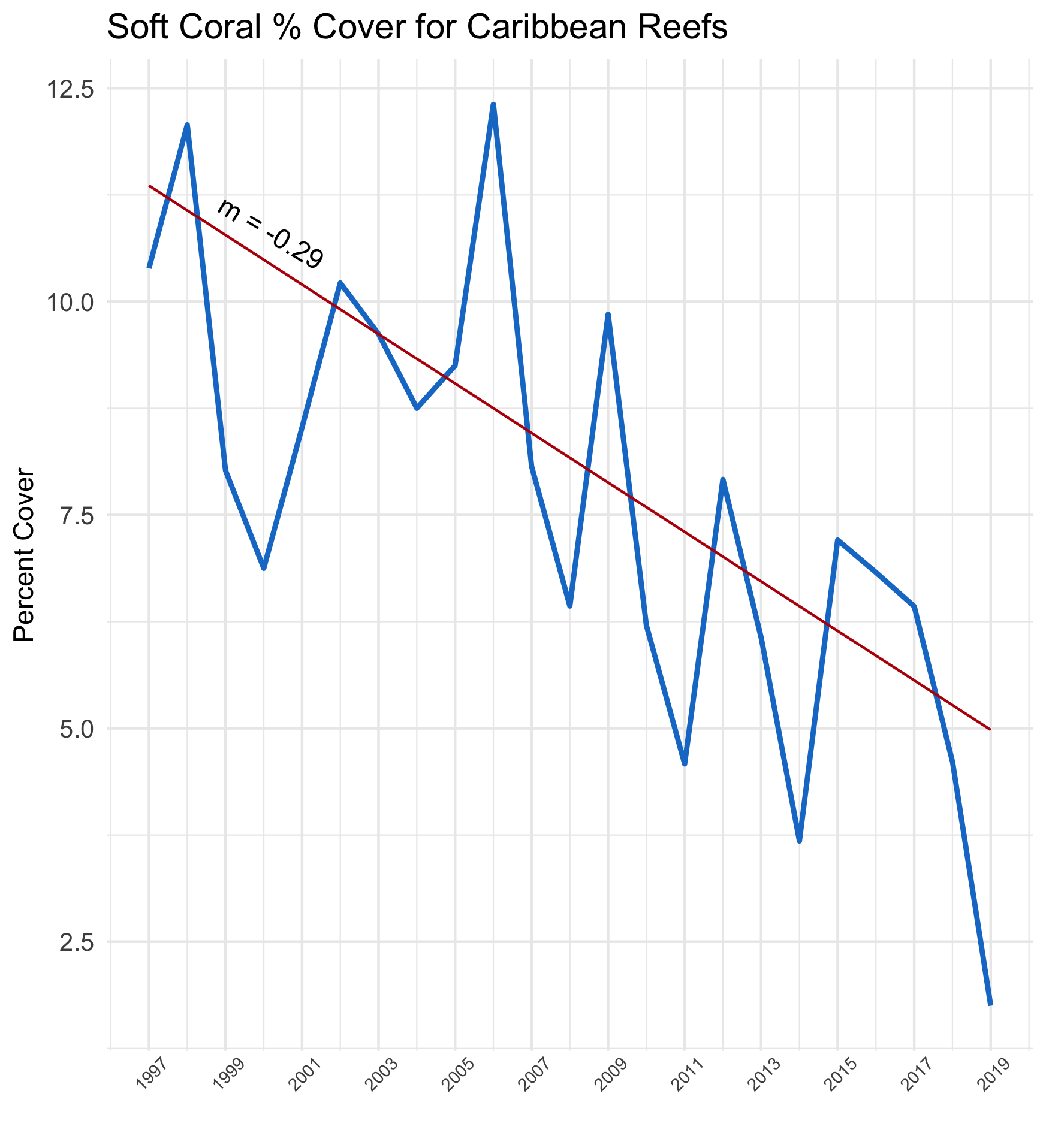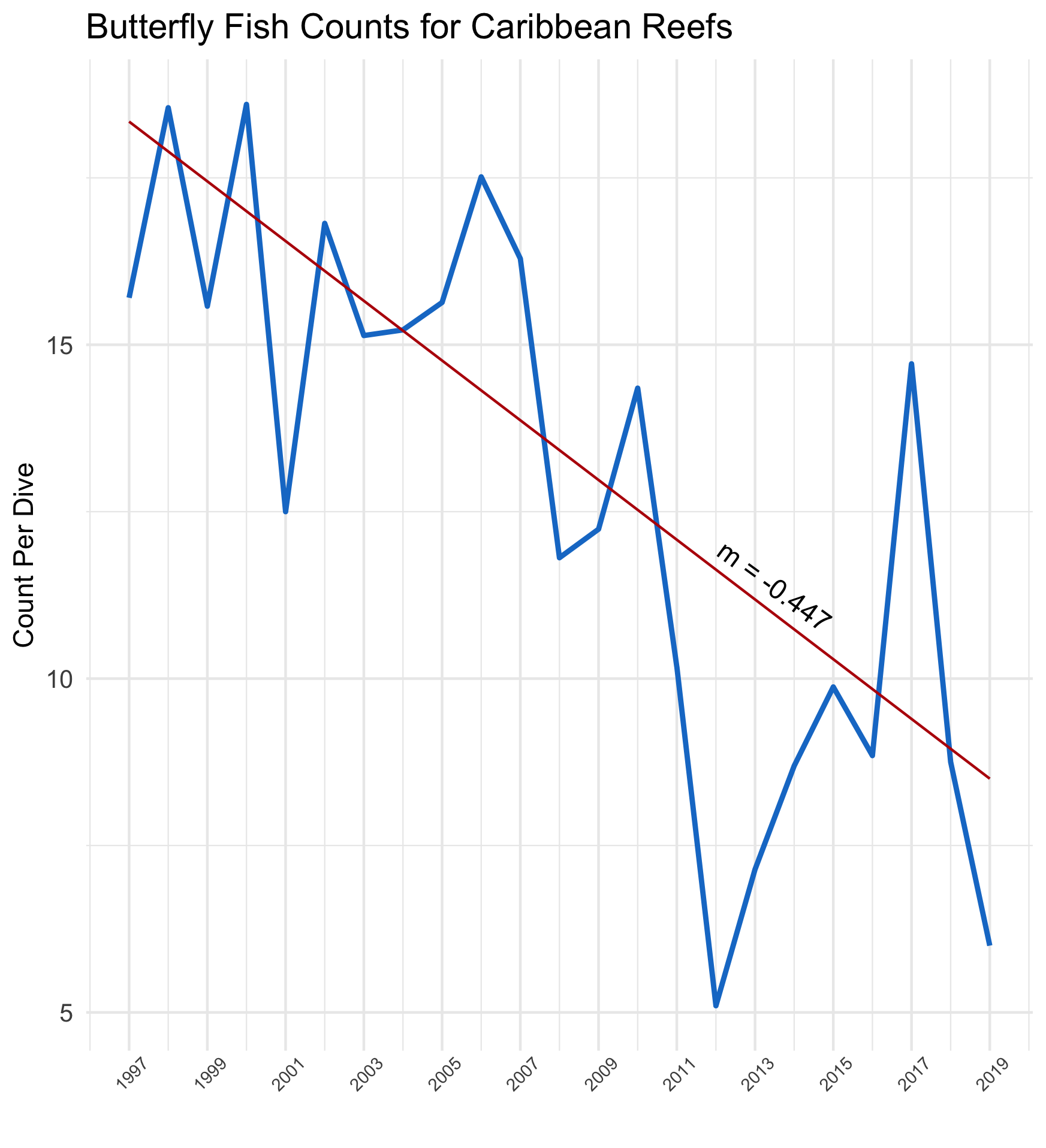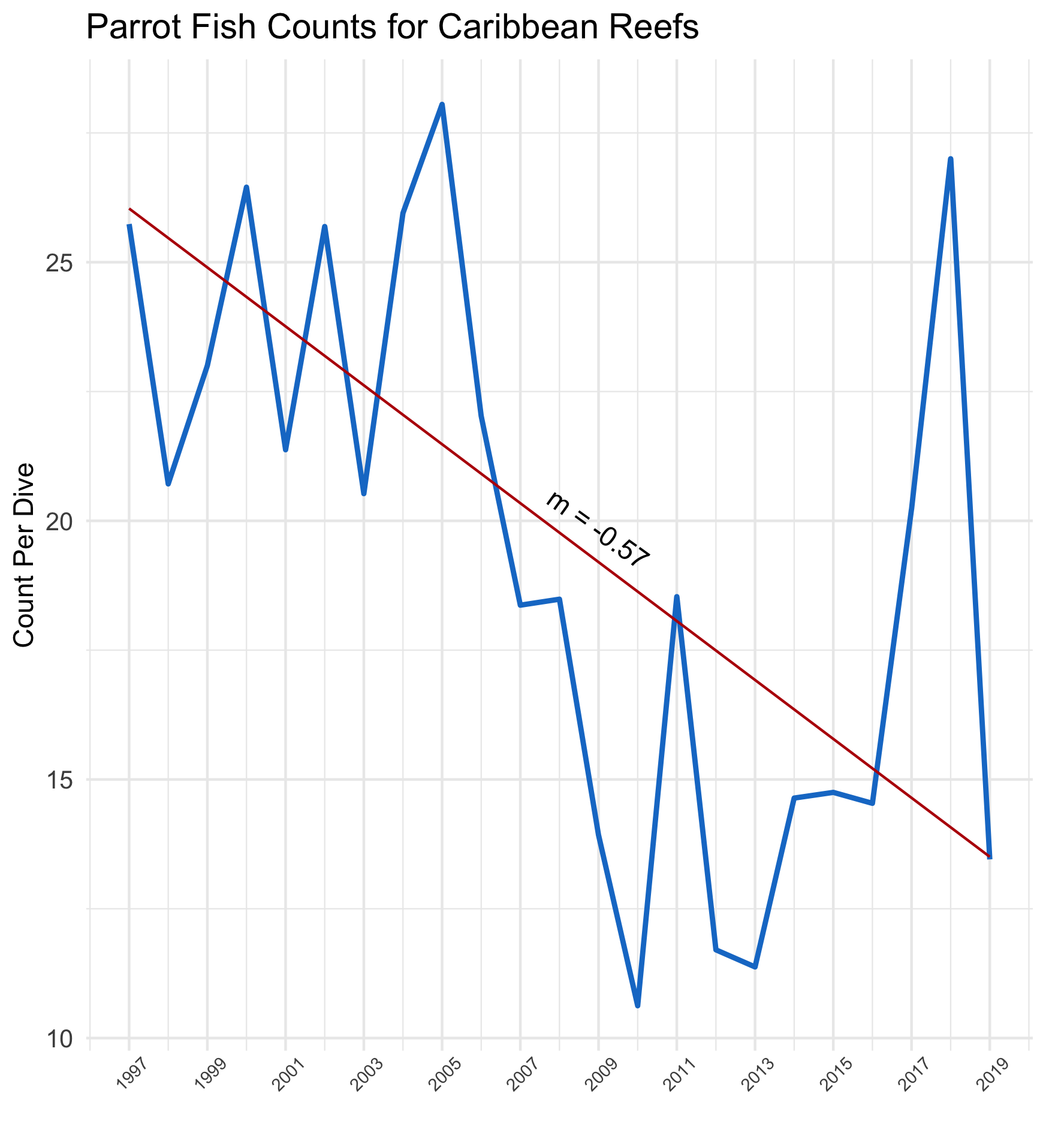加勒比海兔
Ok, here’s a million dollar question: is the Caribbean really dying? Or, more specifically, are marine species found on Caribbean reefs becoming less abundant?
好吧,這是一個百萬美元的問題:加勒比海真的死了嗎? 或者,更具體地說,加勒比海珊瑚礁上發現的海洋物種是否減少了?
To answer this question we’ll need to pick our weapons of analysis, namely…
要回答這個問題,我們需要選擇分析武器,即…
- An annual time series plot. 年度時間序列圖。
- Linear regression with weights. 帶權重的線性回歸。
Surprisingly, these tried and true methods give us plenty of insight into the data (we’ll find an excuse to break out neural nets another day). In the meantime, we have four plots below, each of which shows a different marine organism’s average annual count over the past 22 years. So, let’s jump right in.
出乎意料的是,這些經過實踐檢驗的真實方法為我們提供了對數據的大量洞察力(我們會找到借口再突破神經網絡)。 同時,我們在下面有四個圖,每個圖顯示了過去22年中不同海洋生物的平均年計數。 因此,讓我們直接進入。
硬珊瑚和軟珊瑚的分析 (Analysis of Hard and Soft Corals)
The first of our charts depicts the centerpiece, the make-or-break of any coral reef: hard corals. Hard corals, or reef-building corals, are fantastically intricate living rocks. They provide both food and shelter to a wide range of marine organisms. Long story short, without reef-building corals, reefs would not exist.
我們的第一張圖表描繪了核心,即任何珊瑚礁的成敗:硬珊瑚。 堅硬的珊瑚,或造礁的珊瑚,是錯綜復雜的活石。 它們為多種海洋生物提供食物和庇護所。 長話短說,沒有造礁珊瑚,就不會有珊瑚礁。
Now the amount of hard coral is often measured by percent coverage, that is, from a birds-eye-view, the percent of an area that is covered. In Figure 1 (left), we can see that the weighted regression line has a slope of -0.3; this corresponds to a 0.3 decrease in percent coral coverage every year.
現在,硬珊瑚的數量通常是通過覆蓋率百分比來衡量的,也就是說,從鳥瞰角度來看,所覆蓋區域的百分比。 在圖1(左)中,我們可以看到加權回歸線的斜率是-0.3。 這相當于每年珊瑚覆蓋率下降0.3。
0.3%? That’s it? Yes we’ve lost roughly 7.2% of our coral coverage in the past 22 years. But remember this is percent coverage; using the fitted values, the total percent change is -28%. Moreover, prior research suggests that since the 1950’s, we’ve lost around 50% of Caribbean hard corals.
0.3%? 而已? 是的,在過去22年中,我們已經失去了大約7.2%的珊瑚覆蓋率。 但是請記住,這是百分比覆蓋率; 使用擬合值,總變化百分比為-28%。 此外,先前的研究表明,自1950年代以來,我們損失了大約50%的加勒比硬珊瑚。
Dying: 1.
垂死:1。
Not-Dying: 0.
未死:0。
For our second case, let’s look at soft corals. Soft corals are the Robin to a hard coral’s Batman. Rooted at the base similar to a tree, they grow upwards in search of sunlight and can often be seen flowing in ocean currents. While they have less structural importance than their harder counterparts, soft corals are still an integral part of reef food chains.
對于第二種情況,讓我們看一下軟珊瑚。 軟珊瑚是硬珊瑚蝙蝠俠的羅賓。 它們像樹一樣扎在樹根上,向上生長以尋找陽光,經常看到它們在洋流中流動。 盡管它們的結構重要性不如較堅硬的珊瑚,但軟珊瑚仍然是珊瑚礁食物鏈中不可或缺的一部分。

As shown in Figure 2, soft corals show an even stronger negative trend relative to their initial value. They too have decreased by about 7.2%, but because they started with only 11.6% total cover, their percent change is -57.4%. In 2019, the average diver would see a striking 1.7% cover for soft corals.
如圖2所示,軟珊瑚相對于其初始值顯示出更大的負趨勢。 它們也下降了約7.2%,但由于它們最初僅覆蓋11.6%的總覆蓋率,因此其變化百分比為-57.4%。 在2019年,普通潛水員的軟珊瑚覆蓋率將達到驚人的1.7%。
Despite this dismal trend, it’s interesting to note that after almost every decrease in percent cover, soft corals appear to rebound. Once again we have evidence that nature can be resilient when given the opportunity.
盡管出現這種令人沮喪的趨勢,但有趣的是,在幾乎每度減少百分比覆蓋率之后,軟珊瑚似乎就會反彈。 我們再次有證據表明,如果有機會,大自然可以復原。
Reasons for coral mortality are well-documented and have been for the past 15 years. Despite a long list of culprits, the most cataclysmic cause of coral death is the infamous coral bleaching, which occurs when water temperatures become too hot or cold. There were around five main bleaching events in the Caribbean that overlap with our time series, but I would like to highlight three that occurred in 1997, 2005, and 2015. Let me know if you see any relationships.
珊瑚死亡的原因已有充分的文獻記載,并且已經過去15年了。 盡管有大量罪魁禍首,但造成珊瑚死亡的最主要災難性原因是臭名昭著的珊瑚褪色,這是在水溫過高或過低時發生的。 加勒比地區大約有五起主要的漂白事件與我們的時間序列重疊,但我想強調一下三起發生在1997年,2005年和2015年的事件。如果您有任何關系,請告訴我。
魚的分析 (Analysis on Fish)
The above information is not new. However, relatively little time series analysis has been done on things that move, for example, fish.
以上信息不是新的。 但是,對諸如魚的移動物體進行的時間序列分析相對較少。
So, on to the third of four figures. Here we will be looking at the prolific yet uniquely colorful butterfly fish. Fun fact of the day: butterfly fish mate for life. A less fun fact (but still reasonably fun) is butterfly fish are omnivorous but rely on coral for a large portion of their diets.
因此,到四個數字的第三個。 在這里,我們將研究多產但獨特的彩色蝴蝶魚。 一天的有趣事實:蝴蝶魚終生相伴。 一個不那么有趣的事實(但仍然很有趣)是蝴蝶魚是雜食性的,但是大部分時間都依賴珊瑚。

As shown in Figure 3 to the left, butterfly fish counts have declined precipitously over the past 22 years. Moreover, there is a striking resemblance to the trends exhibited by hard coral, lagged by roughly a year. For instance, the plunge in coral from 2006–2011 is almost identical to the plunge in butterfly fish from 2007–2012.
如左圖3所示,在過去22年中,蝴蝶魚的數量急劇下降。 而且,與硬珊瑚表現出的趨勢有著驚人的相似,大約滯后了一年。 例如,2006-2011年珊瑚的暴跌幾乎與2007-2012年蝴蝶魚的暴跌相同。
Using a weighted regression line to summarize, over the past 22 years the average number of butterfly fish per dive has decreased by a count of 10, equating to a 52.5% decline.
使用加權回歸線進行總結,在過去22年中,每次潛水的蝴蝶魚平均數量減少了10個,相當于下降了52.5%。
Dying: 3.
垂死:3。
Not-Dying: still 0.
未死:仍為0。
It’s not looking good
不好看
On to the final figure. In this graph we will be discussing the aptly named parrot fish. Arguably the ugliest beautiful fish, the parrot fish is brightly colored from beak to tail. Yes, it has a beak.
到最后的數字。 在此圖中,我們將討論恰當命名的鸚鵡魚。 可以說,鸚鵡魚是丑陋的最丑的美麗魚,從喙到尾巴顏色鮮艷。 是的,它有喙。

Parrot fish use this beak to break off chunks of hard coral and because they adhere to a strict coral diet, one would expect their numbers to be closely linked to hard coral percent cover.
鸚鵡魚使用這種喙來分解堅硬的珊瑚,并且由于它們堅持嚴格的珊瑚飲食,因此人們希望它們的數量與堅硬的珊瑚覆蓋率緊密相關。
According to Figure 4, that theory has some supporting evidence. In 2005, the year of arguably the most catastrophic bleaching event in recent Caribbean history, we see a massive drop-off in fish counts. However, the symmetry between butterfly fish and hard coral is surprisingly not observed with parrot fish.
根據圖4,該理論有一些支持證據。 在2005年,可以說是近代加勒比海歷史上最災難性的漂白事件,我們看到魚類數量大幅度下降。 然而,鸚鵡魚卻沒有發現蝴蝶魚和堅硬的珊瑚之間的對稱性。
Now, why the spike in 2018? Great question. After looking through the literature, there was no conclusive evidence.
現在,為什么會在2018年飆升? 好問題。 查閱文獻后,沒有確鑿的證據。
However, despite our lack of understanding of the drivers of these trends, we can still observe and summarize them: parrot fish have decreased by 48% over the past 22 years with a year over year change of -0.57 in counts per dive.
但是,盡管我們對這些趨勢的驅動力缺乏了解,但我們仍然可以觀察和總結它們:鸚鵡魚在過去22年中下降了48%,每次潛水計數同比變化了-0.57。
A side note, parrot fish showed one of the strongest negative trends out of all fish observed.
附帶說明,鸚鵡魚是所有觀察到的魚中最強烈的負面趨勢之一。
結論 (Conclusion)
Hopefully this analysis was able to shed some light onto our initial question of “is the Caribbean really dying?” While these four species (or grouping of species in the case of hard and soft corals) are by no means a representative sample of the Caribbean, they certainly can be used as proxies for reef health. And, it’s clear that hard corals, soft corals, butterfly fish, and parrot fish are all in decline.
希望這一分析能夠闡明我們最初的問題“加勒比海真的死了嗎?” 雖然這四個物種(或硬或軟珊瑚而言,不是物種的集合)絕不是加勒比地區的代表性樣本,但它們無疑可以用作珊瑚礁健康的代理。 而且,很明顯,硬珊瑚,軟珊瑚,蝴蝶魚和鸚鵡魚都在下降。
Personally, what makes these problems so interesting (other than sharks are cool) is the fact that a large portion of society has ignored these findings. Is it charity burnout? Maybe. But I think observing these trends is almost pointless; we already know this stuff. Instead, we need to build tools that quantify and forecast ocean damage, ideally in dollars.
就個人而言,使這些問題如此有趣(除了鯊魚很酷)的原因是,很大一部分社會都忽略了這些發現。 是慈善倦怠嗎? 也許。 但是我認為觀察這些趨勢幾乎是沒有意義的。 我們已經知道這些東西。 相反,我們需要構建工具來量化和預測海洋破壞,最好以美元為單位。
That’s my humble opinion. If you have thoughts or ideas, please leave a comment or reach out.
那是我的拙見。 如果您有想法或想法,請發表評論或聯系。
資料來源 (Sources)
Animals, A. (2019, November 08). Butterfly Fish. Retrieved August 14, 2020, from https://a-z-animals.com/animals/butterfly-fish/
Animals,A.(2019年11月8日)。 蝴蝶魚。 于2020年8月14日從https://az-animals.com/animals/butterfly-fish/檢索
Buddemeier, R. W. (2003). Coral Reef Decline in the Caribbean. Science, 302(5644), 391c-393. doi:10.1126/science.302.5644.391c
布德邁爾,RW(2003)。 加勒比海的珊瑚礁下降。 科學, 302 (5644),391c-393。 doi:10.1126 / science.302.5644.391c
Caribbean coral reef decline began in 1950s and 1960s from local human activities. (2020, April 22). Retrieved August 14, 2020, from https://www.sciencedaily.com/releases/2020/04/200422214047.htm
加勒比珊瑚礁的下降始于1950年代和1960年代,原因是當地的人類活動。 (2020年,4月22日)。 于2020年8月14日從https://www.sciencedaily.com/releases/2020/04/200422214047.htm檢索
Crcp. (2016, April 19). NOAA’s Coral Reef Conservation Program (CRCP) — Coral Facts. Retrieved August 15, 2020, from https://coralreef.noaa.gov/education/coralfacts.html
Crcp。 (2016年4月19日)。 NOAA的珊瑚礁保護計劃(CRCP)-珊瑚事實。 于2020年8月15日從https://coralreef.noaa.gov/education/coralfacts.html檢索
Mu?iz-Castillo, A. I., Rivera-Sosa, A., Chollett, I., Eakin, C. M., Andrade-Gómez, L., Mcfield, M., & Arias-González, J. E. (2019). Three decades of heat stress exposure in Caribbean coral reefs: A new regional delineation to enhance conservation. Scientific Reports, 9(1). doi:10.1038/s41598–019–47307–0
Mu?iz-Castillo,AI,Rivera-Sosa,A.,Chollett,I.,Eakin,CM,Andrade-Gómez,L.,Mcfield,M.,&Arias-González,JE(2019)。 加勒比珊瑚礁暴露于熱應力的三十年:加強保護的新區域劃定。 科學報告, 9 (1)。 doi:10.1038 / s41598–019–47307-0
The data were collected by Reef Check, a coral conservation non-profit that trains volunteer divers to collect marine data. With 1576 unique entries for the Caribbean ranging from 1997–05–24 to 2019–08–24, there were plenty of data points to conduct a TS analysis. However, due to variations in the dive sites, specifically location and time, annual means for the entire Caribbean were calculated. Finally, the least squares regression line was weighted to account for the number of samples each year; early and modern years had less dives than middle years.
數據是由珊瑚礁非營利組織Reef Check收集的,該組織培訓志愿潛水員收集海洋數據。 從1997–05–24到2019–08–24,在加勒比地區共有1576個唯一條目,其中有大量數據點可以進行TS分析。 但是,由于潛水地點,地點和時間的差異,計算了整個加勒比海地區的年均收入。 最后,對最小二乘回歸線進行加權,以說明每年的樣本數量。 早期和現代的潛水次數少于中年。
Here is the code.
這是代碼 。
Note: these are my findings. If you would like to contact me, leave a message here. All criticisms are welcome.
注意:這些是我的發現。 如果您想與我聯系,請在此處留言。 歡迎所有批評。
翻譯自: https://medium.com/data-diving/marine-species-trends-in-the-caribbean-sea-dc948167ccda
加勒比海兔
本文來自互聯網用戶投稿,該文觀點僅代表作者本人,不代表本站立場。本站僅提供信息存儲空間服務,不擁有所有權,不承擔相關法律責任。 如若轉載,請注明出處:http://www.pswp.cn/news/388871.shtml 繁體地址,請注明出處:http://hk.pswp.cn/news/388871.shtml 英文地址,請注明出處:http://en.pswp.cn/news/388871.shtml
如若內容造成侵權/違法違規/事實不符,請聯系多彩編程網進行投訴反饋email:809451989@qq.com,一經查實,立即刪除!




)



![[Egret][文檔]遮罩](http://pic.xiahunao.cn/[Egret][文檔]遮罩)








![【洛谷】P1641 [SCOI2010]生成字符串(思維+組合+逆元)](http://pic.xiahunao.cn/【洛谷】P1641 [SCOI2010]生成字符串(思維+組合+逆元))
